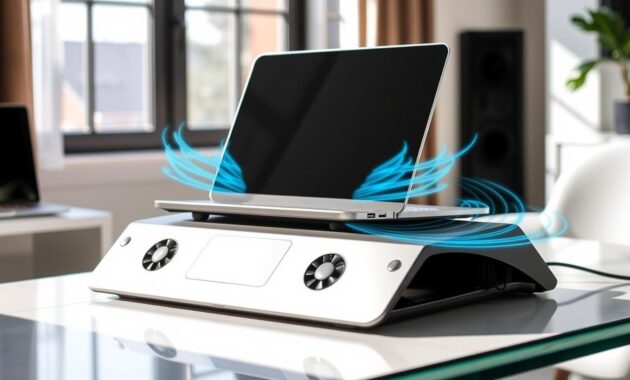Overheating in laptops is a big problem. It can make your laptop slow and even damage it. In this guide, we’ll teach you how to prevent overheating and manage laptop thermals like a pro.
We’ll cover everything from why laptops overheat to how to cool them down. You’ll learn how to keep your laptop cool and efficient, no matter what you’re doing.
Laptops are key to our daily lives. They help us work, play, and stay in touch. But, they can get too hot, which is bad for them.
Too much heat can make your laptop slow and even break it. This can cost a lot to fix. Learning how to manage your laptop’s heat is important. It keeps your device running well and saves you money.
Understanding Common Causes of Laptop Overheating
Laptop overheating can be really frustrating. But knowing why it happens is the first step to fixing it. There are many reasons, like the environment, hardware problems, and software that uses a lot of power. By tackling these issues, you can keep your laptop running smoothly and last longer.
Environmental Factors
The place where you use your laptop matters a lot. Things like the room’s temperature, sunlight, and air flow can make it hot. Laptops work best between 50°C to 70°C (122°F to 158°F). But if it gets too hot, over 90°C (194°F), it can get damaged.
Hardware-Related Issues
Problems with the laptop’s parts can also make it hot. Dust, broken fans, and old thermal paste can block heat from escaping. Also, old batteries and outdated parts can make more heat than the laptop can handle.
Software-Intensive Activities
Some programs can make your laptop very hot. Video editing, 3D modeling, and games use a lot of power. Also, too many tabs open, background apps, and old software can make it worse.
Knowing why laptops get hot helps you fix the problem. Keep your environment cool, clean your laptop, and use software wisely. These steps can help prevent and solve laptop overheating issues.

Essential Steps to Prevent Overheating and Manage Laptop Thermals
Keeping your laptop cool is key for it to work well and last long. By following a few important steps, we can manage laptop heat and keep it running smoothly. Let’s explore the main ways to stop your laptop from overheating.
- Proper Laptop Positioning: Make sure your laptop sits on a flat, stable, and well-ventilated surface. Don’t use it on soft places like beds or couches. They can block air and make it hotter.
- Regular Cleaning: Clean your laptop’s cooling system often. This includes the vents, fans, and heatsinks. Dust and dirt can block air and cause it to overheat.
- Cooling Solutions: Use external cooling devices like laptop cooling pads or stands. They help air flow better and ease the strain on the cooling system.
- Power Management: Adjust your laptop’s power settings to balance performance and cooling. Choose a power plan that saves energy and lowers CPU speed when not needed.
- Software Updates: Keep your laptop’s operating system, drivers, and software current. Updates often fix thermal issues and improve performance.
- Monitoring Temperatures: Use tools to check your laptop’s CPU and GPU temperatures. This helps you spot and fix overheating problems quickly.
By following these steps, you can keep your laptop cool and running well. A well-cared-for laptop is a reliable and long-lasting friend.

“Maintaining a healthy laptop is like tending to a garden – it requires regular attention and care to thrive.”
Proper Laptop Placement and Ventilation Techniques
Keeping your laptop cool is key to its performance. Simple steps can help prevent overheating. This ensures your laptop works at its best.
Optimal Surface Selection
The surface you use can affect your laptop’s cooling. Soft places like beds block vents and reduce airflow. Use hard surfaces like desks for better air flow.
Using a small book or laptop stand can also help. It keeps your laptop cool and stops it from overheating.
Airflow Management Strategies
- Make sure vents have enough space for air to flow. Keep objects away from your laptop.
- In hot places, put your laptop near a window or fan. This improves cooling.
- Clean your laptop’s vents and fans often. Dust can block airflow and heat up your laptop.
Using Laptop Cooling Pads
A good cooling pad can protect against overheating. These pads have fans that pull heat away from your laptop.
Choose a pad with adjustable fan speeds and USB ports. Some pads even monitor temperature and adjust cooling levels.
| Feature | Cooling Pad A | Cooling Pad B | Cooling Pad C |
|---|---|---|---|
| Fan Speed Adjustment | Yes | Yes | No |
| USB Ports | 2 | 3 | 1 |
| Temperature Monitoring | Yes | No | No |
| Estimated Value | $39.99 | $49.99 | $29.99 |

By using these tips, you can keep your laptop cool. This ensures it works well, even when you’re using it a lot.
Maintaining and Cleaning Your Laptop’s Cooling System
It’s important to keep your laptop’s cooling system in good shape. This helps prevent overheating and keeps your laptop running smoothly. Overheating can cause slowdowns, blue screens, or even make your laptop restart on its own.
Laptops are getting smaller and thinner. This makes them more likely to overheat because they have less room for air to flow.
Regularly cleaning your laptop’s vents and fans can help a lot. It stops dust from building up and makes your laptop cool better. Here’s how to keep your laptop’s cooling system in top shape:
- Use compressed air to gently clean the fans and vents, removing any accumulated dust or debris.
- If possible, open the laptop case and carefully clean the internal components, paying special attention to the heatsinks and fans.
- Check the functionality of the fans regularly and replace any faulty ones promptly to ensure efficient cooling.
- Consider seeking professional cleaning services for a thorough and comprehensive maintenance of your laptop’s cooling system.
Keeping your laptop’s cooling system clean and well-maintained is key for good thermal performance. It stops overheating problems. By spending a little time on laptop cooling system maintenance, you’ll have a cooler, more reliable laptop that lasts longer.
| Product | List Price | Estimated Value |
|---|---|---|
| Lenovo Laptop Cooling System Maintenance Kit | $19.99 | $24.99 |

“Regular maintenance of your laptop’s cooling system is the key to preventing overheating and ensuring its long-term performance.”
Advanced Cooling Solutions and Hardware Upgrades
Laptops need to stay cool to work well. Overheating can hurt performance and damage parts. We can use special cooling solutions and upgrades to keep them cool.
Thermal Paste Application
Applying new thermal paste is a smart move. It helps move heat from the CPU/GPU to the heatsinks. A fresh coat can really help your laptop stay cool.
Cooling Pad Selection
A good cooling pad can make a big difference. They have fans that help move heat away. Look for one that fits your laptop well and is quiet.
Fan Upgrade Options
Upgrading your laptop’s fans can help too. New fans can move more air and keep things cooler. But, it’s a job for someone who knows what they’re doing.
For the best cooling, you could try a water cooling system. It’s more complicated but works great for gaming laptops.
Using these cooling solutions and upgrades can keep your laptop running smoothly. It helps it last longer and work better.
Monitoring and Managing CPU Temperature
It’s important to watch your CPU temperature to avoid overheating. This helps keep your laptop running well. Use tools like Core Temp or HWMonitor to check your CPU temperature. This way, you can catch any thermal problems early and keep your laptop cool.
Knowing what temperature is normal for your CPU is crucial. Most CPUs stay between 30°C to 40°C (86°F to 104°F) when idle. But, when you’re gaming or doing heavy tasks, they can get hotter, up to 60°C to 85°C (140°F to 185°F).
Thermal throttling is another thing to watch out for. It happens when your CPU slows down to cool down. By using fan control software, you can keep your CPU cool and running at its best. This prevents it from slowing down too much.
| Software | Platform | Price | Key Features |
|---|---|---|---|
| Core Temp | Windows | Free | Comprehensive CPU temperature monitoring, fan control, and overheating prevention |
| Fanny | Mac | Free | Intuitive CPU temperature monitoring for Mac users |
| iStat Menus | Mac | $12 | Advanced system monitoring with detailed CPU temperature data |
Also, you can try undervolting your CPU to make it cooler while still performing well. By managing your CPU temperature, you can make sure your laptop works smoothly. This also helps your hardware last longer.
Optimizing Software Performance for Better Thermal Management
To keep our laptops cool, we need to optimize software performance. We can do this by controlling background processes, managing browser tabs, and adjusting power settings. These steps help reduce heat and improve our laptops’ thermal efficiency.
Background Process Control
Many apps and services running in the background can make our laptops hot. We should regularly check and close any unnecessary processes. This helps lower the system’s workload and heat output, improving thermal management.
Browser Tab Management
Today, we often have many tabs open at once. Each tab uses system resources and generates heat. To improve browser efficiency, we can use extensions like The Great Suspender. It automatically closes inactive tabs, reducing strain on our laptop’s hardware and improving thermal performance.
Power Settings Adjustment
Changing our laptop’s power settings can greatly affect thermal management. By choosing a balanced or power-saving mode, we can limit CPU performance and reduce heat. Regular software updates that improve power management and thermal control also help.
| Optimization Technique | Benefit |
|---|---|
| Background Process Control | Reduces CPU and system utilization, lowering heat generation |
| Browser Tab Management | Decreases resource consumption and thermal output from open tabs |
| Power Settings Adjustment | Balances performance and energy efficiency, mitigating heat buildup |
By using these software optimization strategies, we can manage our laptop’s thermals better. This prevents overheating and ensures a reliable, efficient computing experience.
Professional Tips for GPU Cooling and Performance
To cool your GPU and boost gaming, try a few strategies. Start by undervolting or underclocking your GPU. This cuts down heat without losing too much power. Use tools made for GPUs to watch temperatures and tweak fan settings to keep your card cool.
Good airflow in your case is key for cooling your GPU. Make sure your PC has enough room for air to flow in and out. For laptops, using an external GPU enclosure can help a lot. It gives better performance and keeps your laptop cooler than built-in graphics.
Also, always update your graphics drivers. Drivers from NVIDIA, AMD, or Intel can make your GPU work better and cooler. By using these GPU cooling techniques, graphics card optimization, and gaming performance tips, you’ll get a cooler and more powerful PC.




